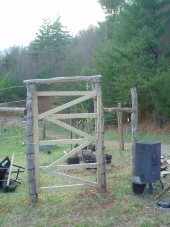
 3
3




Where my chicks have roamed no grass grows!
 4
4




 1
1




C Davis wrote:I love this topic! My family is also preparing to bring in a few goats. They will be rotational grazing in about 8 acres of woods. We have a ton of kudzu, brambles, and grapevines on the edge of our woods, too.
I have a question for all of you who have experience with rotational grazing in the woods where you move them from one electric netting paddock to another… what do you do about shelter for the goats, since they need shelter from rain? Do you have some sort of lightweight skiddable shelter? I have been trying to come up with a plan for something that the goats won’t be able to knock over/climb on/fall through, yet is light enough to move around in the woods by one person.
You have to be tough or dumb - and if you're dumb enough, you don't have to be so tough...
 2
2




 2
2




Joshua LeDuc wrote:
C Davis wrote:I love this topic! My family is also preparing to bring in a few goats. They will be rotational grazing in about 8 acres of woods. We have a ton of kudzu, brambles, and grapevines on the edge of our woods, too.
I have a question for all of you who have experience with rotational grazing in the woods where you move them from one electric netting paddock to another… what do you do about shelter for the goats, since they need shelter from rain? Do you have some sort of lightweight skiddable shelter? I have been trying to come up with a plan for something that the goats won’t be able to knock over/climb on/fall through, yet is light enough to move around in the woods by one person.
C, I built a plywood floor on two pallets that I screwed together, and then built a back wall, two side walls and a sloped roof. I then covered all in corrugated metal sheeting. This way I can move the shelter around with the pallet forks on my tractor. I also put wooden "skis" on the bottom of the two pallets so I could pull the shelter as well with a chain or strap. Finally, I put 4 brackets with holes on the sides of the skids so I can stake down the shelter. I use trampoline wind stakes. I learned the lesson of staking down the shelter the hard way. One evening we had a storm roll through with really high winds and the shelter tipped over trapping one of the goats underneath it. Luckily she didn't get injured and is doing okay.

 1
1




 Perhaps this could be another arm of business and then the mohair to spin, maybe?
Perhaps this could be another arm of business and then the mohair to spin, maybe? Failure is a stepping stone to success. Failing is not quitting - Stopping trying is 
Never retire every one thinks you have more time to help them - We have never been so busy 
 3
3




. . . bathes in wood chips . . .
 2
2




 2
2




"The world is changed by your example, not your opinion." ~ Paulo Coelho
 2
2








Steve Smyth wrote:Speaking to the picketing concerns:
Never picket an animal without a responsible human keeping tabs on them.
I am leaning towards portable electric fencing.
Do you all think than Nubians would be a good breed to start with?
Thanks.
Once you make a decision, the universe conspires to make it happen. - Ralph Waldo Emerson




Krista Galitsis wrote:I am thinking about getting goats to help clear our land. While I see the normal brush and small trees, a few brambles we also have lots of Bracken fern. Now I have concerns about my plan since I have learned that bracken are poisonous in all parts of the plant and that this causes the development of bladder, stomach and other cancers. The toxin deposits in milk and meat of omnivores and can be passed to consumers. I was researching the allopathic effects of bracken on surrounding plants when I came across this. Am I making too much of this or should I consider other ideas for clearing some of the woods?
Once you make a decision, the universe conspires to make it happen. - Ralph Waldo Emerson
 1
1




Heather Staas wrote:
Yup, my Katahdin hair sheep were excellent at both grazing and browsing. They'd easily clear out poison ivy, multiflora, knotweed, shrubbery, saplings, sumac... only a very few things they wouldn't eat. I grazed them for a little time in a mature apple orchard and they did a GREAT job of clearing it out and pruning up the suckers to about shoulder on a human height. Young trees they'd probably damage if left in too long, but mature trees had no problems. I used to have before/after orchard pictures, maybe I can find them.
Once you make a decision, the universe conspires to make it happen. - Ralph Waldo Emerson
 1
1







